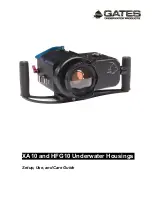
(15189) Precipitation Sensor
Operating Instructions
Operating Instruction
Precipitation Sensors (15189) + (15189 H)
Initial operation
If the sensor system has been completely mounted and
electrically assembled, the sensor will be ready for operation.
An operational check has to be performed.
Maintenance and operational check
The precipitation sensor is nearly maintenance-free. The
sensor should be checked and cleaned periodically in order
to guarantee its proper operation, because dirt accumulation
may cause errors of measurement. The time interval of clean-
ing depends on the local conditions.
The
operational check
of the sensor may be performed by
the use of arti
fi
cial precipitation. The volume of a 200 cm³
resp. 400 cm³ (by 4 cm³ buckets ) test container of water must
be piped into the collecting funnel through a nozzle in such a
way that the drops fall into the funnel beside the outlet. The
nozzle of the test container (approx. diameter 0.6 mm) should
be adjusted to allow a complete water run out into the funnel
within 10 to 12 minutes.
After the arti
fi
cial precipitation has gone through, 100 ± 2
bucket tippings should have counted.
Rinse the sensor thoroughly for cleaning. Clinging particles
of dirt in the collecting funnel or outlet pipe may be removed
with a piece of wood.
If unsatisfying measurement results occur after this cleaning
procedure, the tipping bucket should be disassembled for
cleaning.
Absolute care must be taken not to damage the
tipping bucket!
The dismounted tipping bucket can be cleaned by placing it
in warm water with some scouring material and by carefully
scraping off unwanted dirt by using a small piece of wood.
Warranty
Please note the loss of warranty and non-liability by unau-
thorised manipulation of the system. You need a written
permission from LAMBRECHT meteo GmbH for changes
of system components. These activities must be operated
by a qualifi ed technician.
The warranty does not cover:
1. Mechanical damages caused by external impacts (e. g.
icefall, rockfall, vandalism).
2. Impacts or damages caused by over-voltages or elec-
tromagnetic
fi
elds which are beyond the standards and
speci
fi
cations in the technical data.
3. Damages caused by improper handling, e. g. by wrong
tools, incorrect installation, incorrect electrical installation
(false polarity) etc.
4. Damages which are caused by using the device beyond
the speci
fi
ed operation conditions.
5


























